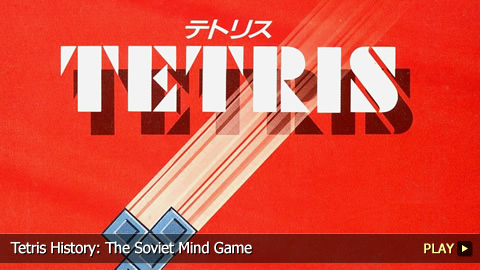Tetris History: The Soviet Mind Game

The Cold War
The story of this popular video game began as the Cold War raged in the USSR. During this period, Russian engineer Alexey Pajitnov was working at the Soviet Academy of Sciences in Moscow, and it was there that he tried to bring his favorite game to the computer screen in 1984.
Basic Computer Game
Tetrominoes involved fitting different geometric shapes into a rectangle without any spaces. With help from colleague Dmitry Pavlovsky, Pajitnov developed a simple computer game using basic graphics and no sound on an Elektronika 60.
Gameplay
Pajitnov’s game took the principles involved in Tetrominoes and added the challenge of gravity. The blocks in his game were comprised of four squares that formed different shapes, and they would fall at increasingly higher speeds as the levels passed. The aim was to make full horizontal lines, which would then disappear. If a gap was left in the line, that line would remain until the player was able to fill the hole.
The Birth of Tetris
All the game needed was a name: Pajitnov took his inspiration, Tetrominoes, added his favorite sport, tennis, and Tetris was born. Pajitnov’s colleague Vadim Gerasimov soon ported the game to the IBM PC.
Tetris Spreads
It wasn’t long before co-workers at the Computer Center were all addicted to Tetris. In the summer of 1985, a color version was created and it was this edition that quickly spread through Moscow. Eventually, Tetris made its way to Budapest, Hungary where a British software company came across it.
Rights Battle
Because Pajitnov worked for the Soviet government, his intellectual property was owned by the state. For this reason, it took him years to claim any money from his creation. Tetris soon became the subject of a rights war between the Soviet government’s foreign trade organization Elorg, and a number of western companies.
Tetris in the U.S.
In the midst of these legal battles, a questionably official PC version of Tetris hit the United States market in 1986.
Popularity in America
Tetris was the first Soviet game to make it to U.S. audiences, and it was marketed as a piece of culture from behind the Iron Curtain. It was vastly different from everything else on the U.S. market at the time: instead of shooting, guns and chases, it was a game of order and thought. Like everyone who had played the game before them, the American public became addicted to Tetris and the Soviet mind game was a huge hit.
Tetris on the Game Boy
But still, no one officially had the rights to the game. Finally, after years of back-and-forths between numerous companies including video game giant Atari, Henk Rogers and Nintendo emerged as winners of the Tetris rights in 1989. Nintendo decided to bundle Tetris with their popular home console, the NES, as well as their new handheld terminal, the Game Boy, in the hope that the game would help their products appeal to a wider audience.
Original Game
The original Game Boy version featured greyscale graphics and iconic theme music, and was similar to Pajitnov’s original creation.
Pajitnov Gets His Due
In 1996, Pajitnov finally began receiving royalties when rights to the game reverted from Russia to him. That year he and Henk Rogers started the Tetris Company to manage licensing in the U.S. Pajitnov also began working for Microsoft in 1996, after moving to the States five years earlier.
The Tetris Effect
Following years of popularity on the market, the game was the subject of scientific study. It was found that prolonged play caused users to see the real world as a game of Tetris, in terms of how things fit together. This was officially categorized as a form of hallucination, and was nicknamed the Tetris Effect.
Effect on PTSD
It 2012, it was also suggested that the game could help prevent symptoms of Post-Traumatic Stress Disorder.
Tetris’ Legacy
Since its creation, Tetris has become a phenomenon that spans cultures and races, and appeals to the gamer in everyone. It has spawned sequels, imitators and improvements, is available on numerous devices and continues to sell millions of copies as one of history’s most popular video games. Experts claim Tetris can never be won – but it sure is fun to try.
